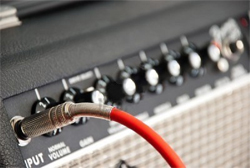
3. Approach Panning as Part of Leveling
Carefully consider how the panning of your guitar tracks affects their balance relationships.
The loud, dominant guitar tracks in any hardcore genre that include vocals are an easy example.
Since the guitars are supposed to be ‘loud’ compared with the vocal, they are usually panned far left and/or right to avoid obscuring the vocal altogether.
Otherwise, one might be tempted to raise the vocal level, which would reduce the impact of the guitar content.
Think of this as mixing (panning) for separation, in order to preserve distinct balance choices.
On the other hand, if your guitar track is “part of” another instrument’s sound you might consider panning to avoid musical separation. Keeping such musical layers panned together or symmetrically opposed helps maintain the aural illusion that they are tonal components of a single instrument.
You’re simply deciding whether that’s going to be a mono or stereo instrument.
4. Refine the Tone of Your Guitar Content ‘In Place’
With the musically essential choice about function established by rough balance and reinforced by smart panning, it makes sense to address how the harmonic content of the guitar tracks can be optimized.
There’s no point in pretending to relate EQ specifics (or even most generalities), but if the guitar tracks you’re working with haven’t already fallen victim to knob twisting, there are some themes that might help organize your decision-making.
The fundamental frequencies of the guitar lay largely between 160 Hz -1300 Hz. In reality, your typical rock or country rhythm track is probably played in the 160 Hz-700 Hz range.
This frequency band will provide ‘fullness’, ‘warmth’, or even ‘muddiness’ when accentuated. The same range can be attenuated to get thinner, less supported tones. Try starting in the 350 Hz-500 Hz range with your center frequency.
Boosting a wide peak approximately two octaves above the fundamental frequency center can very easily, naturally brighten picked performances on metal-stringed instruments. This is the frequency range in which these instruments are naturally bright, so it pays to play along.
Below about 80 Hz even the most theoretical harmonic contribution to your guitar sound has been exhausted. Don’t hesitate to high-pass filter guitar tracks to prevent non-programmatic low frequency content from messing with your gain staging and dynamics control.
Working From a Musically Relevant Basis
Notice we haven’t touched a single multi-band compressor or 8-bit distortion-cruncher-thing. Tricks aren’t tricks unless the tracks are working in the arrangement (i.e. for the song).
Starting with these types of basic considerations can take decent tracks most of the way to musical effectiveness, and take excellent tracks all the way.
Rob Schlette is chief mastering engineer and owner of Anthem Mastering (anthemmastering.com) in St. Louis, MO, which provides trusted specialized mastering services to music clients across North America.
Be sure to visit the Pro Audio Files for more great recording content. To comment or ask questions about this article go here.
